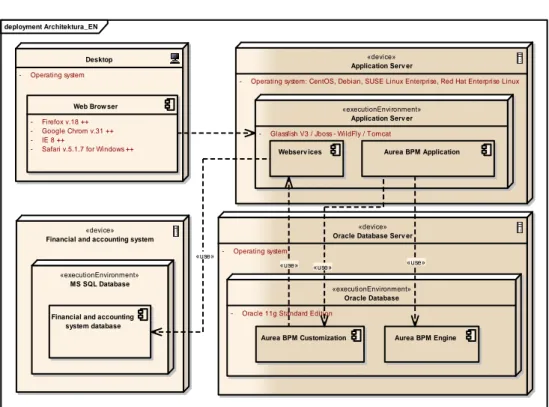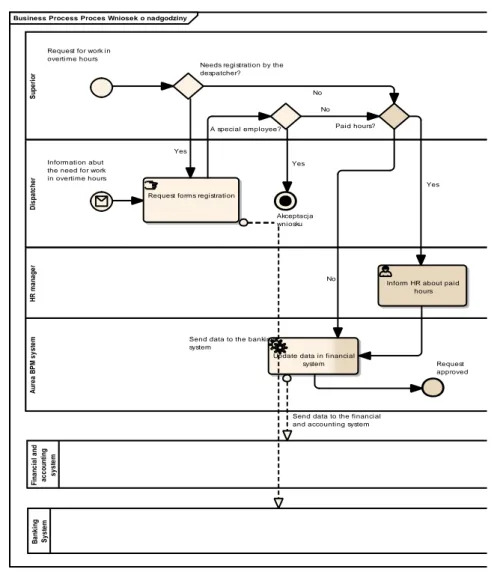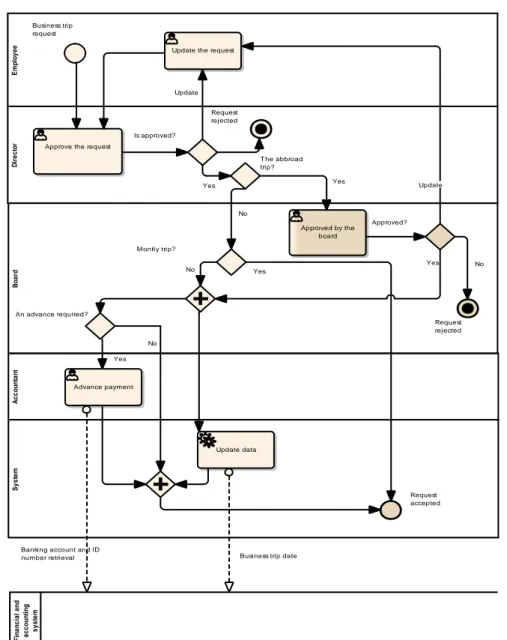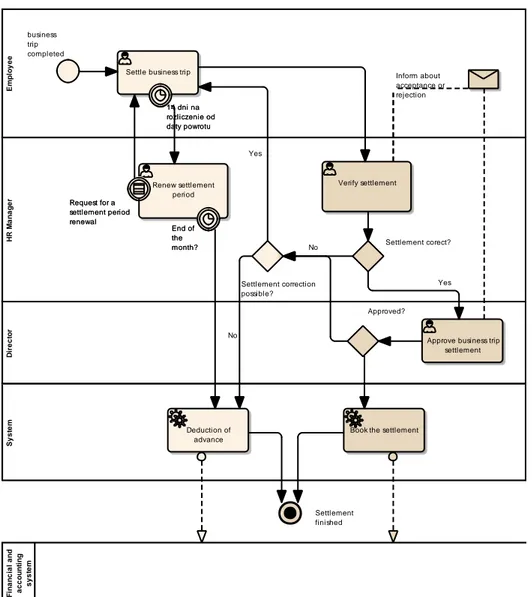IMPROVING BACK OFFICE EFFICIENCY WITH
BUSINESS PROCESS MANAGEMENT SYSTEM
Robert Waszkowski
Cybernetics Faculty, Military University of Technology, Kaliskiego 2, 00-908, Warsaw, Poland, E-mail: robert.waszkowski@wat.edu.pl
Abstract: The paper outlines the concept for using the Business Process Management System (BPMS) to improve back office processes in an organization. The BPM system allows organization of all back-office tasks into processes that could be measured and improved. The aim of the paper is to prepare reference business process models for common back office activities. The process models were prepared in accordance with the BPMN (Business Process Model and Notation). The results of the conducted research prove that the measured business processes may be not only managed, but also subsequently improved.
Paper type: Research Paper Published online: 30 April 2018 Vol. 8, No. 2, pp. 189–201
DOI: 10.21008/j.2083-4950.2018.8.2.6 ISSN 2083-4942 (Print)
ISSN 2083-4950 (Online)
© 2018 Poznan University of Technology. All rights reserved.
Keywords: modeling, business process management, business analysis, back-office
1. INTRODUCTION
The BPM, i.e. Business Process Management is more often a management concept in a given company than a complex IT system. However, it should be remembered that to increase the quality of the management process in a measurable manner, such complex IT systems are required and even indispensable in large companies. Therefore, more and more companies is interested in the implementation of the BPM tools (Dirk, 2009).
The Business Process Management (BPM) refers to the management of business processes, i.e. via IT tools (Nowicki, Waszkowski & Saniuk, 2016; Jasiulewicz-Kaczmarek, Saniuk & Nowicki, 2017), which allows managers to monitor completion of the process to produce better results. Since every business process is subject to management, BPM may be applied in all processes. In fact, it is most often used to build workflow systems in companies. Additionally, BPM is often applied in administrative, financial and customer service processes (van der Aalst & van H. Kees, 2002).
The BPM solutions are most frequently used to handle processes related to the document flow in companies, e.g. approval of purchase invoices or their equivalents, as well as internal documents, such as holiday request forms or business trips. Therefore, the systems are most likely to be successfully implemented in the public sector, in all shared service centres and large organizations regardless of the sector in which they operate (Jonkers, 1996; Waszkowski, Nowicki & Kiedrowicz, 2017).
The article outlines a number of possibilities to improve back-office processes by using the Business Process Management systems.
2. SYSTEM ARCHITECTURE
The architecture of the business process management system and program interfaces for the environment systems are shown in figure 1 below.
In the full architectural variant, the system is composed of the following elements: application server, database server, client station, server for the financial and accounting systems, including interfaces between such systems.
The application server may be installed on the following operating systems: CentOS, Debian, SUSE Linux Enterprise or Red Hat Enterprise Linux. Glassfish V3, JBoss, WildFly or Tomcat constitutes software for the application server. Aurea BPM and program interfaces in the form of Web Services have been installed on the application server.
The application server processes data managed by the database server installed on Red Hat Enterprise Linux or Cent OS. The Oracle Management System and Aurea BPM engine for the business process management system have been installed on the database server.
deployment Architektura_EN
Desktop
- Operating system
«device» Oracle Database Serv er
- Operating system
Web Brow ser
- Firefox v.18 ++ - Google Chrom v.31 ++ - IE 8 ++
- Safari v.5.1.7 for Windows ++
«executionEnvironment» Oracle Database
- Oracle 11g Standard Edition
Aurea BPM Engine Aurea BPM Customization
«device» Application Serv er
- Operating system: CentOS, Debian, SUSE Linux Enterprise, Red Hat Enterprise Linux
«executionEnvironment» Application Serv er
- Glassfish V3 / Jboss - WildFly / Tomcat
Aurea BPM Application
«device» Financial and accounting system
Webserv ices
«executionEnvironment» MS SQL Database
Financial and accounting system database
«use»
«use» «use»
«use»
Fig. 1. Architecture and interfaces of the Business Process Management System; own elaboration
The MS SQL system and database used by such system are installed on a separate computer, which forms the server for the financial and accounting system.
The client stations may operate on any computer with Firefox, Chrome, Internet Explorer, Edge or Safari web browsers.
3. BUSINESS PROCESSES
3.1. Process – Holiday request form
The holiday request process may be executed by an employee or person authorized thereto. The person filing the request on behalf of a third party shall perform this action from its own account in the Aurea BPM system by designating the request as on-behalf-of request.
After the process is initiated, the system sends appropriate information to the holiday register by updating the holiday request status at every stage of the process.
Business Process Holiday Request F In a n c ia l a n d a c c o u n ti n g s y s te m A u re a B P M s y s te m S u p e ri o r E m p lo y e e Request submission
Update the request
Approve Is approved? Update data Request rejected Request approved File the request
Is the fiscal month closed?
Request canceled
Yes Needs update
No
Send data about the request to the financial system
Nie
Fig. 2. Diagram of the Process – Holiday request form in BPMN; own elaboration
The employee or person authorized to file the requests on behalf of such employee shall initiate the process and complete all the information related to the request.
The date of request, details of the requesting party and number of the request are automatically completed, without a possibility of changing the data by the employee.
On the basis of data of the employee filing the holiday request (or on behalf of whom such request is filed) and type of the chosen holiday leave, the financial and accounting information about the number of days or hours of such annual leave entitlement of the employee is downloaded.
In case of positive feedback from the financial and accounting system, Aurea BPM automatically calculates the number of days of the annual leave, with respect to which the employee (or a person authorized thereby) filed a request in the Aurea BPM system, which days have not been appropriately processed and, hence, are presented in the non-editable field – "Number of holidays in acceptance".
The Aurea BPM system compares the number of days or hours of the requested annual leave against the available holiday limit (the limit constitutes the difference between the number of days or hours of the annual leave from the financial and accounting system and the number of days or hours of the annual leave from other unaccepted requests of the employee) and determines whether the employee should be allowed to take the annual leave or not.
While calculating/receiving the number of days or hours of the annual leave entitlement, a possibility of granting the leave within a given period of time when compared to the scheduled dates is additionally checked.
Upon acceptance of the request by the employee, an automatic e-mail is generated, including the information on the request waiting for approval of the superior and its assistants.
The holiday request is sent to the superior of the employee for the purpose of its verification. The superior may accept, reject or send the request for revision. In each of the above-mentioned cases, the employee shall be informed about the decision of the superior via e-mail.
Upon acceptance of the holiday request by the superior, the information on the annual leave is sent to the financial and accounting system, which automatically removes the requested number of holidays from the holiday limit to which the employee is entitled.
3.2. Process – Instruction to work in overtime hours
The instruction to work in overtime hours may be given by the superior of the employee or persons authorized in that respect (e.g. dispatcher).
The dispatcher shall initiate the process if the employee reports such need; the process refers to specific groups of employees.
After the process is initiated, the system sends appropriate information to the overtime register by updating the request status at every stage of the process.
The superior or person authorized to file request forms shall initiate the process and complete all the information related to the request.
The date of request, details of the requesting party and number of the request are automatically completed, without a possibility of changing the data by the employee. The request number shall be calculated using special algorithm.
The superior or dispatcher shall choose the employee, for whom the overtime is requested.
The requesting party shall complete the fields related to the date of overtime assignment: Date, hour of commencement and completion of the work, overtime code (selection from the list). Additionally, the mandatory field for the description of the reason for overtime needs to be completed.
Business Process Proces Wniosek o nadgodziny H R m a n a g e r F in a n c ia l a n d a c c o u n ti n g s y s te m B a n k in g S y s te m A u re a B P M s y s te m D is p a tc h e r S u p e ri o r
Request for work in overtime hours
Information abut the need for work in overtime hours
Request forms registration Needs registration by the despatcher?
Paid hours?
Inform HR about paid hours
Update data in financial
system Request
approved A special employee?
Akceptacja wniosku
Send data to the banking system
Yes
No
No
Yes
Send data to the financial and accounting system Yes
No
Fig. 3. Diagram of the Process – Instruction to work in overtime hours; own elaboration On the basis of the date and hours entered by the requesting party, the Aurea BPM system automatically calculates the number of overtime hours and by using the overtime code - defines the method of compensation.
Upon filing of the request by the superior, an e-mail informing the employee about the need to work overtime is sent.
If the request is entered by the superior for specific groups of employees, the process is directed to the dispatcher, who includes the information about the overtime in external systems and accepts the request by acknowledging safe receipt of the information.
In case of the requested paid overtime, an e-mail informing thereof must be sent to the employee from the H&R or Financial Department.
Upon acceptance of the request by the employee from the H&R or Financial Department, the information about the overtime hours is sent to the financial and accounting system.
3.3. Process – Request for business trip
The process related to the request for business trip may be executed by an employee or person authorized thereto (administrative and technical employee). The person filing the request on behalf of a third party shall perform this action from its own account in the Aurea BPM system by designating the request as on-behalf-of request.
The process for handling business trips was divided into two subprocesses related to the filing and settlement of the request after coming back from the business trip.
Business Process Proces Wniosek o delegację i rozliczenie
Business trip requested Business trip Settlement of business trip Business trip settled Request for business
trip
Financial and accounting system
Business Process Zlozenie w niosku o delegacj e F in a n c ia l a n d a c c o u n ti n g s y s te m S y s te m A c c o u n ta n t B o a rd D ir e c to r E m p lo y e e Business trip request
Approve the request
Is approved?
Update the request
T he abbroad trip? Approved by the board Request rejected Approved? Update data An advance required? Advance payment Request accepted Request rejected Montly trip? No Yes
Banking account and ID number retrieval
Yes No
Business trip date
Update No Yes Yes No Update Yes
Fig. 5. Request for business trip and advance payment
The employee or person authorized to file the requests on behalf of such employee shall initiate the process and complete all the information related to the request.
Business Process Rozliczenie delegacj i F in a n c ia l a n d a c c o u n ti n g s y s te m S y s te m H R M a n a g e r E m p lo y e e D ir e c to r business trip completed 14 dni na rozliczenie od daty powrotu Settle business trip
14 dni na rozliczenie od daty powrotu
Approve business trip settlement End of the month? Request for a settlement period renewal Renew settlement period End of the month? Request for a settlement period renewal Approved? Verify settlement Settlement corect?
Book the settlement Deduction of advance Settlement finished Settlement correction possible? Inform about acceptance or rejection No Yes Yes No
Fig. 6. Settlement of business trip and advance payment
The date of request, details of the requesting party and number of the request are automatically completed, without a possibility of changing the data by the employee. The request number shall be calculated using special algorithm.
If the employee goes on a national or international business trip with the national part, the employee shall tick "National business trip" and complete all fields related to this part of the business trip.
Information on the means of transport (selection list). If the employee enters "train" as the means of transport, a special box for specifying the type of the train
and a check-box to request the national rail ticket to be issued by BHS, without seat reservation (Point of Sale), appear. If the employee enters "other" as the means of transport, the employee shall – in accordance with the information on the form – complete the "comment" box and specify the means of transport (e.g. motorcycle).
The requesting party shall complete the box "purpose of business trip" and potentially attach documents confirming such purpose (e.g. conference invitation).
If the employee uses many means of transport, the employee shall specify the above-mentioned information for each of them with respect to both arrival and departure (records possible to be multiplied).
The requested party may apply for the advance payment towards expenses connected with such national business trip. After ticking appropriate options, the requesting party shall be able to determine the amounts necessary to pay for the hotel, transport, etc. Business expenses for the business trip and commuter allowances are calculated automatically in compliance with the binding provisions of law. The requesting party shall choose the form of advance payment: personal bank account/automatic withdrawal.
Once the employee accepts the request for business trip, a possibility of the business trip within a given period of time compared to the scheduled dates (in the PK system) is additionally checked. If another event (e.g. holiday leave, other business trip, etc.) is scheduled for the time of the business trip (PK system), the PK system shall send an appropriate message to Aurea BPM informing about the type of such event that makes it impossible to file the request (for both national and international business trip).
The director or its assistants may accept, reject or send the request for revision. The person responsible for accepting the request for business trip shall enter a comment when rejecting the request or sending it for revision, providing grounds for such a decision.
Every request for the national or international business trip with the national part shall be examined in terms of its legitimacy by the Member of the Management Board responsible for a given unit in its division. The decision-makers may accept, reject or send the request for revision. The decision to reject the request ends the process. The decision-maker responsible for accepting the request for business trip shall enter a comment when rejecting the request or sending it for revision, providing grounds for such a decision.
If the request for international business trip or international business trip with the national part was accepted by an appropriate Member of the Management Board, e-mails are sent to the employees.
In case of every request for business trip including the advance payment, such advance payment shall be paid to the bank account or automatic withdrawal is made (based on ID card).
After coming back from the business trip, the employee shall have 14 days to settle such trip. On the first day after coming back from the business trip, the Aurea BPM system automatically sends a notification to the employee via e-mail,
informing the employee about the necessity to settle the business trip. If the employee fails to fulfil this task, subsequent notifications are sent automatically on the 10th and 14th day after the date of return from the business trip.
In the settlement of the business trip, the employee shall determine the parameters of the business expenses (number of meals divided into breakfast, lunch and dinner), accommodation (according to bills and allowances) and other costs (according to bills). All expenses not settled according to allowances must be documented by attaching the scanned documents confirming such expenses (bills/invoices).
If the employee used private means of transport, the employee shall additionally complete the trip parameters related to such vehicle (kilometres driven for business purposes, number of vehicle, type of vehicle depending on engine capacity and type). The system automatically calculates the allowance according to the data provided.
The international business trip is settled in an analogous manner, but in this case, the system automatically calculates the business expenses for each country separately.
The system automatically sums up all the expenses related to both national and international business trip and presents a summary of the costs divided into the national and international part (if applicable), and shows the information on whether any deduction or payment shall be made and in which amount.
Once the employee settles the business trip, such settlement is sent to the Director for approval. The system automatically, via e-mail, informs the accepting party (Director) about receipt of the business trip settlement provided by the employee.
If the employee fails to settle the business trip within 14 days from the date of return from such business trip (in case of the national business trip of one month, the deadline is counted from the date of the last return from the requested business trip), the process automatically moves to the step called "Resume settlement" and the employee loses a possibility of handling the settlement process.
4. CONCLUSION
The article outlines the diagram of BPMN back-office processes. The above-mentioned processes were automated via Aurea BPM and implemented in the actual place of employment.
While using the aforesaid processes, the processes were adjusted and amended a number of times to achieve the final form as described herein.
The BPMS systems are perfect for automation of not only core and production business processes (Leymann, 2000). It is also the implementation of back-office processes that plays key role in the operations of an enterprise.
The back-office processes are subject to change and optimization as often as the production processes. The process parameters and their KPIs may be determined for the back-office processes to the same degree as for the production processes. It allows to efficiently implement the systems for assessing the progress of the processes and hence suggest changes and improvements in terms of their execution.
The companies which use BPMS systems instead of ERP systems to handle back-office processes are characterized by more freedom of adapting their activities to the ever changing market conditions. The level of satisfaction of employees and managerial staff with the applied IT systems is much higher in case of flexible BPMS systems than ERP system, in case of which any modifications are more time-consuming and costly.
REFERENCES
Dirk F., Favre C., Jobstmann B., Koehler J., Lohmann N., Völzer H. & Wolf K. (2009) Instantaneous soundness checking of industrial business process models”, 7th Int. Conference on Business Process Management, Springer LNCS 5701, pp. 278–293. Jasiulewicz-Kaczmarek M., Saniuk A. & Nowicki T. (2017) The maintenance management
in the macro-ergonomics context, Advances in Social & Occupational Ergonomics vol. 487, Springer Series, Advances in Intelligent Systems and Computing, Goossens R.H.M. (Ed.), pp. 35–46, ISBN 978-3-319-41688-5.
Jonkers H. & Franken H.M. (1996) Quantitative modeling and analysis of business processes, Simulation in Industry, 8th European Simulation Symposium, vol. I, pp. 175–179.
Leymann F. & Roller D. (2000) Production Workflow: concepts and techniques. Prentice Hall.
Nowicki T., Waszkowski R. & Saniuk A. (2016) Business process analysis of a foodborne outbreak investigation mobile system. In. IV International Conference on Modern Technologies in Industrial Engineering (ModTech 2016), Iasi, Romania, IOP Conference Series: Materials Science and Engineering Vol. 145 (Cohal V. et al. eds.), Bristol : Institute of Physics, pp. 864–868, ISBN: 978-1-5108-2912-1.
W. van der Aalst & M. van H. Kees (2002) Workflow Management, Models, Methods and Systems, The MIT Press Cambridge.
Waszkowski R., Nowicki T. & Kiedrowicz M. (2017) Classified Document Flow Management, in Advances in Social and Occupational Ergonomics: Proceedings of the AHFE 2017, The Westin Bonaventure Hotel, Los Angeles, California, USA (Ed. Richard H.M.Goossens) ISSN 2194–5357, DOI 10.1007/978-3-319-60828-0, Springer International Publishing AG 2018, pp. 62–71, Series: Advanced in Intelligent Systems and Computing No 605, ISBN 978-3-319-60827-3.
BIOGRAPHICAL NOTES
Robert Waszkowski is an assistant professor at Faculty of Cybernetics, Military
University of Technology in Warsaw, Poland. His research interests are focused on business process analysis, modeling and automation, databases, computer simulation, optimization and project management. He is the author of more than 50 scientific publications. He managed many projects in the field of business process management.





